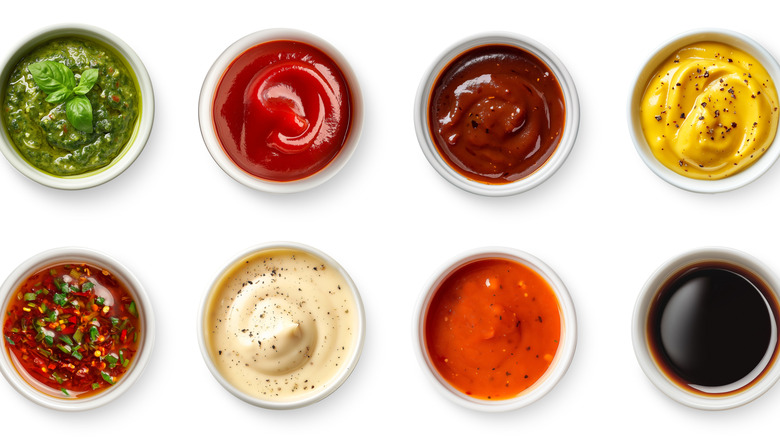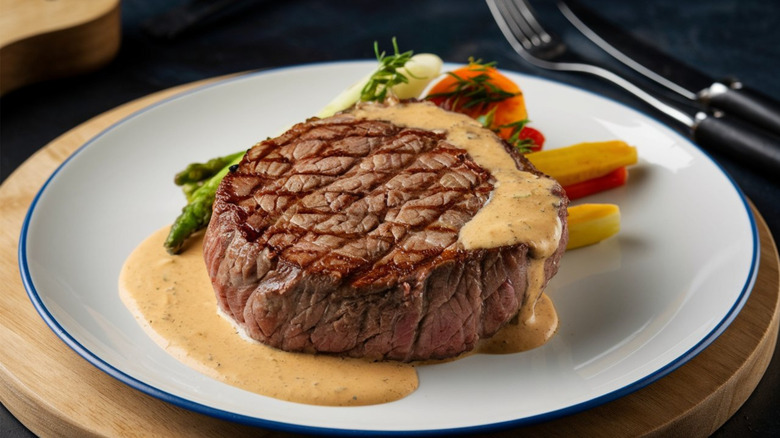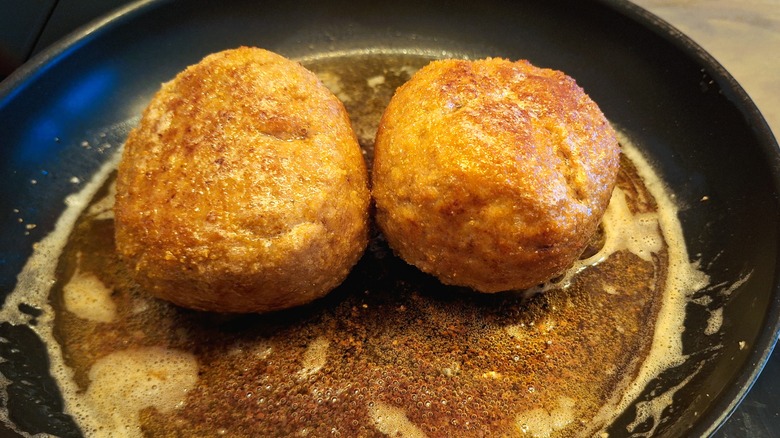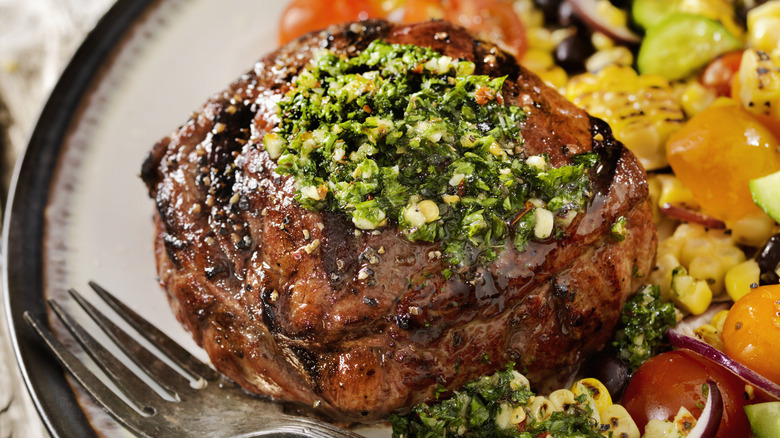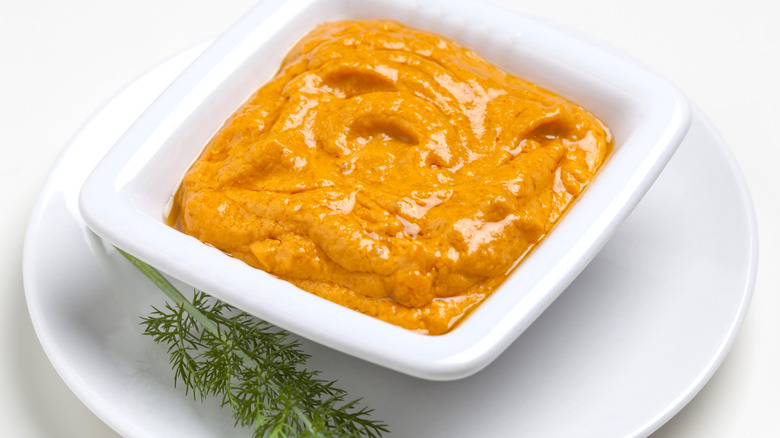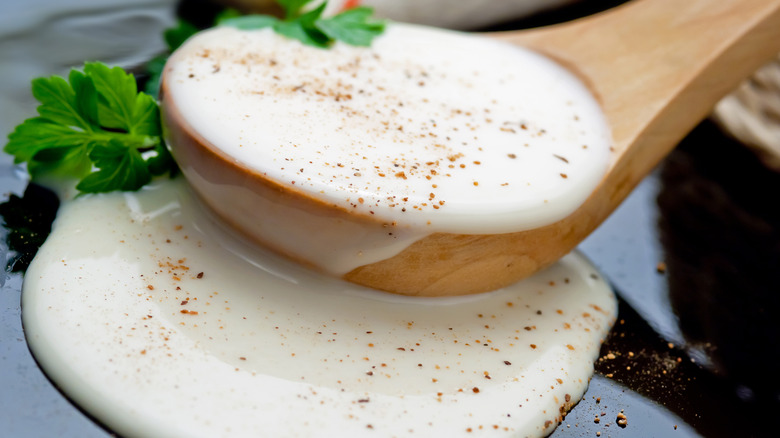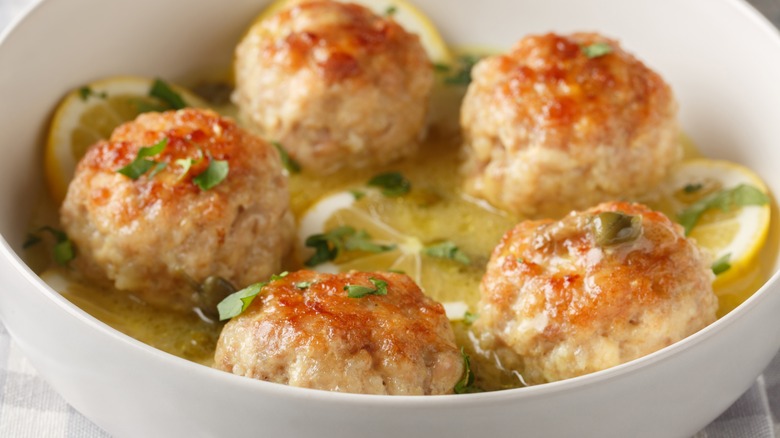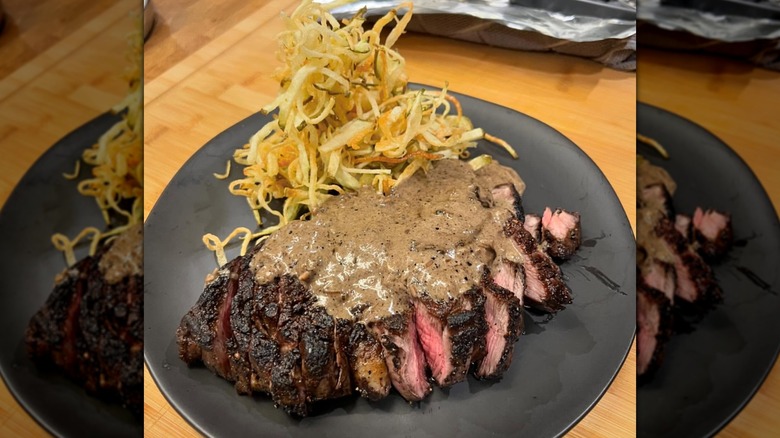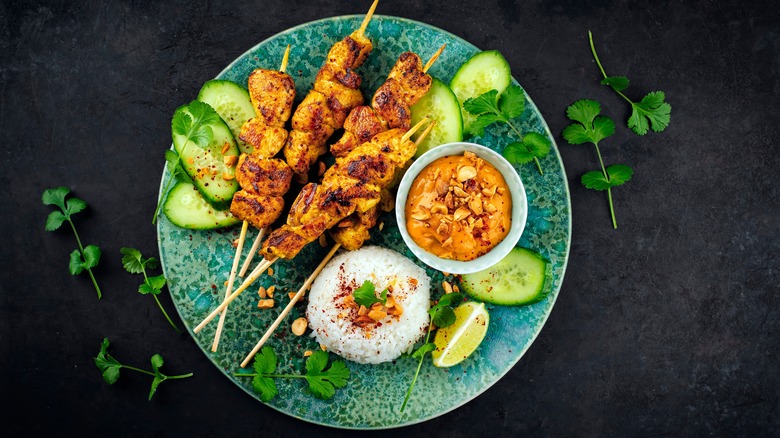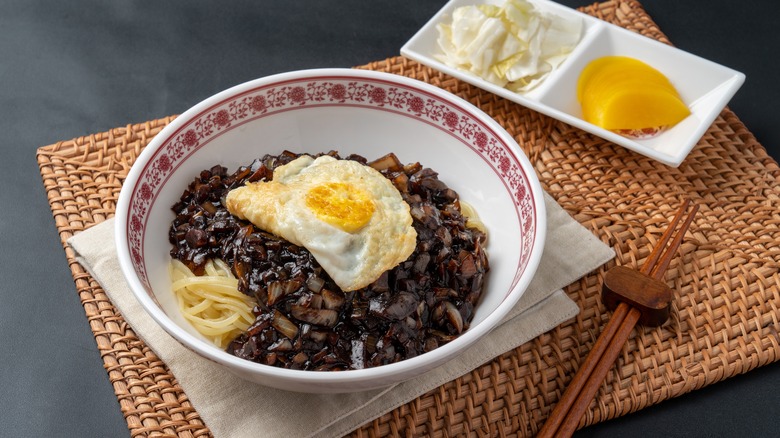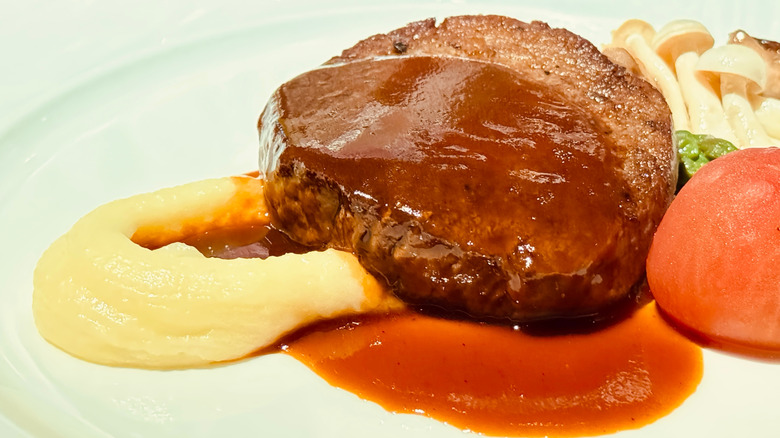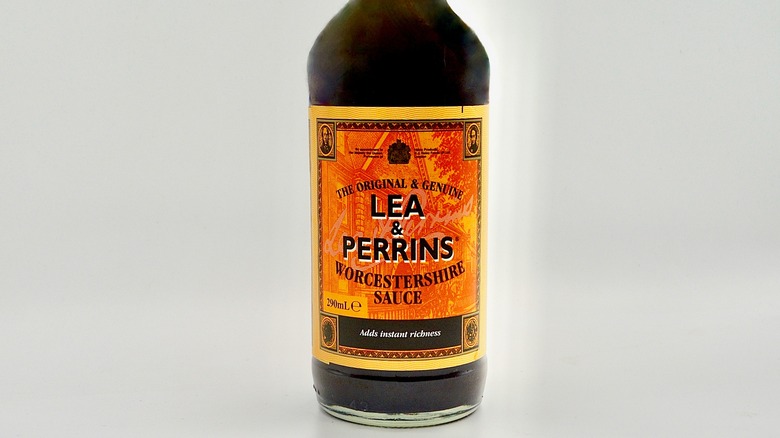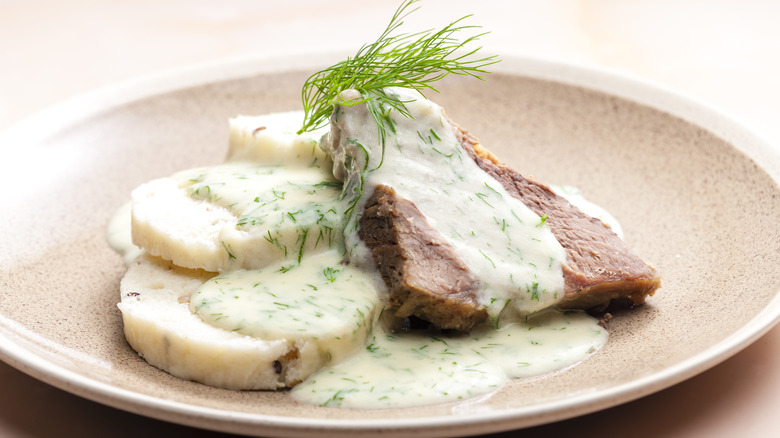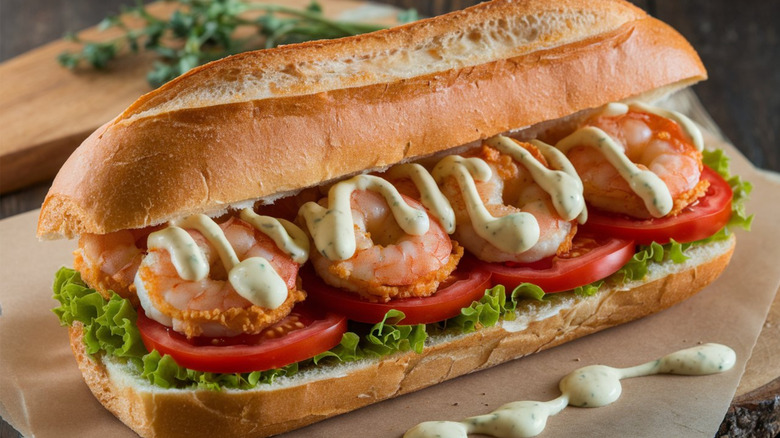14 Sauces That Will Seriously Upgrade Any Bland Meal
What's life without a little sauce? Whatever the answer, it can't be good. Sauce has the power to take ordinary foods like rice and veggies and turn them into a culinary masterpiece. It's a potent addition to any meal because of how dramatically the sauce characterizes everything it touches. The same exact meal will taste almost completely different if you simply switch up the sauce.
Need a quick fix for an insipid bowl of rice and chicken? Sauce it up. Or how about some plain steak with nothing but salt and pepper? That's right, you sauce up that bad boy. While sauce can't truly solve all your culinary woes, it can certainly upgrade a bland meal by many points — were talking taking a four to an eight on a 10-point scale. Here are some sauces that will take your next meal from bland to grand. And best of all, you can make all of them in your own kitchen.
Béarnaise sauce
This is a classic French sauce, considered a special version of one of the five "mother sauces" of France. You may have heard the saying that someone "wouldn't know [insert thing] if it were served to them on a bed of lettuce with sauce béarnaise." Well, if you are the target of this idiom, you may not know what you're eating, but at least the sauce ought to improve its flavor. That's because béarnaise sauce tends to elevate whatever you drizzle it over. The most popular choice seems to be steak, but you can put it on all kinds of things like chicken, pasta, or a savory pie.
Béarnaise sauce is basically just a hollandaise with tarragon and shallots, only with wine vinegar instead of lemon. It tends to work equally well with both vegetables or beef, and it's pretty simple to put together. It's a buttery emulsion if you are trying to imagine the taste, and if you don't whisk it properly, it can easily split. While it might be tempting to simply buy a sauce from the store, a homemade version almost always tastes better.
Brown butter sauce
Buttery and delicious, this is an easy-to-make sauce that will hugely elevate plain old pasta. It works incredibly well with things like tortellini or ravioli. This sauce is, once again, brought to you courtesy of French cuisine, where it is known as "beurre noisette." And though its most obvious use is to elevate savory dishes, it can even be used with sweet ones, too. Ready for the most unusual fact about brown butter sauce? It contains one ingredient: unsalted butter.
This means that most of the process of preparing this sauce is about technique rather than combining ingredients. It truly is just about the easiest sauce to make. Butter contains both milk solids and milk fat, which means that when the butter is melted in a pan, the solids will settle at the bottom. This causes the solids to cook, which turns it brown and creates the sauce's delicious flavor. Be careful, though — it's easy to make a mistake and burn the butter because of butter's naturally low smoke point.
Chimichurri sauce
Traditionally used on steak, there are a ton of other foods that combine perfectly with this sauce. You may have seen this Argentinian special before without realizing it. It's a green pesto-looking sauce with a tangy element and strong herbaceous note. It requires about eight different ingredients to make, depending on personal preference. So while chimichurri is just a teensy bit involved to make at home, there's nothing like a homemade sauce to brighten up any savory meal, although its most famous application is arguably as a condiment for choripán, a popular Argentinian street food. The sauce itself is usually made with red wine vinegar, red pepper flakes, garlic, parsley, oregano, and olive oil. In Argentina, chimichurri is a common marinade or sauce for dipping.
No one knows exactly where chimichurri came from, and legends include stories of Irish immigrants, Basque chefs, and a sauce experimenter named "Jimmy McCurry." Wherever it comes from, it's a delicious and fun addition to all kinds of savory meals that you ought to attempt at least once.
Romesco sauce
Characterized by flavors of roasted tomato and red pepper, this is a zesty sauce with many potential applications. Romesco sauce began in the city of Tarragona, located in northeast Spain just by the French border. Allegedly, romesco was an invention of the port-dwelling fishermen who wanted to add a little zing to the fish they caught. Romesco goes particularly well with grilled or roasted veggies, bringing a fierce zest to any produce, courtesy of two key ingredients: roasted tomatoes and bitxo peppers. It's got a host of other tasty ingredients like garlic, almonds, and smoked paprika.
The final product is a bright, creamy orange paste that's so good you'll be tempted to eat it by the spoonful before it's even applied to the main course. It's got this perfect combination of sweet and smoky flavors that give it a terribly exotic feel, like you're standing over a grassy cliff in rural Spain, watching the sheep graze below. Many different meals represent an excuse to whip out the Romesco, but try it with something as simple as a baguette for dipping.
White barbecue sauce
The South is big on barbecue, especially Texas. But if you're in Alabama, the barbecue obsession persists in the form of reverence for something called white barbecue sauce. A weird stroke of genius once led a guy named Bob Gibson to invent it, and once you try it, you'll understand its almost cult following. A lot of Alabamians serve things like grilled or smoked chicken with white barbecue sauce, but there are honestly few cooked meats it can't spice up with its unique heat and tang.
So how was this sauce invented? Well, Bob Gibson combined mayonnaise and vinegar with barbecue sauce. That's basically it, although you can experiment with a few other ingredients if you decide to try making some at home. Gibson actually founded an entire restaurant around it, a famous joint called "Big Bob's Bar-B-Q." They called him Big Bob due to his 300-pound, 6 foot 4 stature. You can check out the restaurant to try his signature white sauce, or make it at home.
Caramelized pan sauce
This is a special kind of sauce that requires you to make food first — and use the remains in the pan. Home chefs know the drill: You fry up some chicken or steak, adding herbs and spices as you go, and once it's all done, the pan is in need of a good scrub. There are brown, caramelized bits stuck to the base of the pan, but the dishwasher should wash those out, right? Don't do it! There's a name for those little browned bits in the pan: fond. They are the base needed to create a good caramelized pan sauce.
The simplest version of the sauce goes like this: After emptying your pan, return it to the stove on medium-high heat. Then, use a spoon or spatula to scrape the bottom of the pan, which will peel away all those tasty little caramelized pieces. Add onion and shallots, and as the liquid from these latter additions fries away, add the alcohol of your preference — white wine, red wine, bourbon, or whatever will pair best with the meat you plan on using the sauce with. During this process, the alcohol cooks away, so it won't intoxicate you. After a couple minutes, introduce a bit of water to the mix, and voilà: a rich, thick, brown pan sauce perfect for topping steak or chicken.
Lemon caper butter sauce
Often used in Mediterranean cuisine, this sauce relies on the sour power of lemons combined with capers. No one person can take credit for inventing lemon caper butter sauce, but the whole region from which it hails is famous for employing both lemons and capers across a range of different foods. This sauce almost always includes garlic, butter, and white wine, and across the span of years, it has snuck into kitchens everywhere. It's a resourceful sauce with the power to deliciously complement chicken, pasta, veggies, tuna, veal, and fish with its unique blend of savory and tart sensations.
If you've never tried a caper, it's actually a type of flower bud, though some might confuse it on sight for a berry. Capers are sold in small jars at most grocery stores, sometimes near the Italian products or with other condiments. The other key ingredient, lemon, is a potent ingredient, so it may be best to go easy on the lemon if you're making this sauce for the first time. The final product is a vibrant sun-colored mixture that will have you salivating before the meat even hits the frying pan.
Bourbon peppercorn sauce
Steak, burgers, you name it – if it's beef, you can eat it with bourbon peppercorn sauce. Rich, creamy, and possessed of a distinctly peppery kick, it also works on mashed potatoes. If you hadn't noticed, this is a real meat n' taters type of sauce, and it's so good you might be tempted to drink it like a beverage. It does have a soupy, brothy vibe to it, but bourbon peppercorn sauce is at its best when topping a hearty meal.
This sauce is very straightforward to make, and it contains all the ingredients you might expect: bourbon, black pepper, beef stock, and heavy cream. It's almost more of a gravy, to be honest, but if you want it to be even thicker, you can always add some flour. There's no more midwestern dish than a savory, seasoned steak with a healthy serving of rich, velvety bourbon peppercorn sauce to add just the right balance of sweetness and smoke to the meat.
Peanut dipping sauce
An Indonesian favorite, peanut sauce is the key ingredient in certain Thai noodle dishes, lending them an unforgettable aroma that always demands one more bite. Known simply as peanut sauce or satay sauce, it's a major part of Southeast Asian fare, but it's especially popular in Indonesia where they call it "bumbu kacang," translating to "nut bumbu spice." This sauce has been around for centuries ever since they were brought ashore by Iberian sailors.
The sauce is made by roasting or frying peanuts before they are ground up with various other spices, then combined with coconut milk or soy sauce. Recipes for this sauce vary widely, so there's no official way to make peanut sauce. Grilled and skewered meats are perfect for dipping into a bowl of fresh, warm peanut sauce. It's common to coat things like satay or similar meaty treats with this rich, creamy stuff. Peanut sauce also works really well with certain Asian noodle dishes.
Chinese black bean sauce
It's pretty impressive the things you can do with a little fermentation. Black bean sauce is one of those things. Sometimes known as black bean paste, this sauce is a savory addition to chicken, beef, stir fry, tofu, and many other food groups. This entry on our sauce list has been described as "pungent," an olfactory experience resulting from the fermented black beans that compose the bulk of the sauce. These fermented black beans are in fact black soybeans, also known as douchi. To make the sauce, the beans have to be boiled and inoculated with a mold spore while they dry in the hot sun.
"Mold spore" is where a lot of people write off this sauce and move onto something else, but black bean sauce is perfectly safe to eat, and it's a very common addition to entries from Sichuan and Cantonese cuisine. It can be used as a sauce for things like stir fry or as a marinade, depending on what you're preparing in the kitchen. Ingredients for this sauce include garlic, ginger, green onions, saké, rice vinegar, and hot pepper sauce.
Bordelaise sauce
Bordelaise sauce is an umami classic made from red wine, shallots, and beef stock. It's another staple sauce from the elite chefs of France, named for the region from which it hails, Bordeaux — a French city. The name of the sauce is amusingly straightforward, effectively translating to "sauce from Bordeaux." It's famous for its rich, dark red coloring and wine flavor, and it pairs incredibly well with beef steak. The standard recipe involves reducing red wine to concentrate its flavor into a thicker, more potent sauce. You combine that with brown beef stock, and then introduce shallots, bay leaf, and thyme.
Even just a little of this good stuff will have your homemade steaks and roasts tasting like they were served up at a nice restaurant. In addition to the ingredients already listed, all you need is butter, olive oil, and those old standby seasonings, salt and pepper. This sauce will take a simple dish like steak with asparagus and mashed potatoes, and elevate it to master chef level in a short time.
Worcestershire sauce
Everyone has fumbled with the pronunciation of Worcestershire sauce, the English concoction with a secret ingredient you'll never guess. Worcestershire sauce has made an appearance in everything from pasta, pies, steak, and even bloody marys. For the record, it's pronounced "woo-stir-sure," which probably no educated person would guess upon seeing it on paper for the first time. But what about that mysterious ingredient? Well, in addition to things like malt vinegar, molasses, cardamom, curry powder, and many other items (making it at home will require a bit of prep work), Worcestershire features the controversial anchovy, the little silver fish with a perpetual expression of surprise — probably because it can't believe you're actually going to eat it.
Worcestershire that uses anchovy includes these little guys because of the savory, umami flavor they contribute, but some home recipes will avoid the fishy addition for one reason or another. Anchovies or no, this is an appetizingly dark brown sauce with a tangy aroma, and it will elevate any meat that happens to grace your table, be it chicken, beef, or even fish.
Dill sauce
Next time someone calls you a dill weed, assume they mean it as a compliment. Dill is one of the most beloved, flavorful herbs on the planet, and while it's perfect as a light, cool dipping sauce with seafood, creamy dill sauce works equally well as a dip. It can play the role of tartar sauce for your fish and chips, or it can sit in the center of a vegetable platter: the dipping station to which all veggies must travel before they are cleared for entry into your mouth.
Thankfully, given how tasty it is, dill sauce is not a calorically heavy addition to your meal. It's got a real tang to it, an unmistakable zest that supercharges even the blandest fish with its perky energy. And yet it's so creamy that you'd think it was much heavier than it actually is. The recipe includes sour cream, lemon, garlic powder, hot mustard, and, of course, a couple tablespoons of fresh-chopped dill. Serve it with a little sprig of dill on top for that chef's kiss effect.
Remoulade
Last but not least is another entry from the culinary giant that is France. These days, having made it to the Americas, remoulade is a New Orleans staple, and it basically comes in two distinct forms: oil-derived and mayonnaise-derived. It's actually pretty similar to tartar sauce, but it's more savory and includes anchovies just like good old Worcestershire.
It's a popular addition to Cajun and Creole cuisine like crab cakes, fried shrimp, po'boy sandwiches, or even fried green tomatoes. The most popular version of remoulade doesn't require a blender or anything special — you just combine the ingredients in a bowl and stir them up. The recipe calls for ingredients like mayo, mustard, cayenne pepper, paprika, and garlic. It's got a hot intensity to it that meshes just right with the thought of a muggy New Orleans summer evening.

